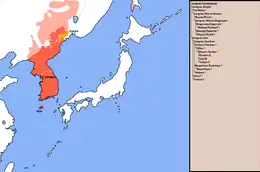| Llingües coreániques | ||
|---|---|---|
| Distribución xeográfica | Estremu oriente | |
| Países |
| |
| Filiación xenética | Aisllada[1][2][3][4][5][6][7] | |
| Subdivisiones |
Llingües fuyu(?) Silla (coreanu, jeju)coreanu y Idioma jeju | |
| Códigu Glottolog | kore1284 | |
|
| ||
| Ver tamién Idioma - Families - Clasificación de llingües | ||
| [editar datos en Wikidata] | ||
Les llingües coreánicas son un grupu de llingües qu'inclúi al idioma coreanu xunto con otros idiomes rellacionaos con él más que con cualesquier otra propuesta que los venceye coles llingües mongóliques, les llingües túrquiques, les llingües tunguses o les llingües xapóniques. Ente les llingües esistentes, dellos llingüistes consideren al coreanu como una llingua aisllada, ente qu'otros incluyir como parte de la controversial familia altaica, anque la fala de la Isla de Jeju considérase lo suficiente distinta como pa ser considerada como llingua en sí mesma por delles autoridaes.
Antigües llingües coreánicas
Dalgunes de les antigües llingües de la península de Corea -Silla, Buyeo, Goguryeo, Dongye, Okjeo, Baekje, Gojoseon y Ye-Maek— pueden ser ancestros, rellacionaos, o parte del coreanu antiguu. Suélense postular dos rames: Fuyu (buyeo) y Han.[8]
- Buyeo (Fuyu, Koguryoic) [estinguíu]: Buyeo, Goguryeo, Buyeo-Baekje. Dacuando tamién s'inclúin les xapóniques.
- Han: Silla → coreanu, jeju
Llingües coreánicas modernes
Plantía:Further El coreanu modernu ye consideráu tradicionalmente como una única llingua. Sicasí, el jeju (Cheju) ye n'ocasiones clasificáu como una llingua distinta, por casu nel atles de la UNESCO de llingües en peligru. si esto ye aceptáu, habría dos llingües coreánicas moderlas, el jeju y el mesmu coreanu.[9]
Ver tamién
- Historia del idioma coreanu
Referencies
- ↑ Song, Jae Jung, The Korean language: structure, use and context, Routledge, p. 15, ISBN 978-0-415-32802-9, https://books.google.com/books?id=rIk52cJ1vDEC&pg=PA15.
- ↑ Campbell, Lyle; Mixco, Mauricio, «Korean, A language isolate», A Glossary of Historical Linguistics, University of Utah Press, pp. 7, 90–91, «most specialists... non longer believe that the... Altaic groups... are related […] Korean is often said to belong with the Altaic hypothesis, often also with Japanese, though this is not widely supported».
- ↑ Dalby, David, The Register of the World's Languages and Speech Communities, Linguasphere Press.
- ↑ Kim, Nam-Kil, «Korean», International Encyclopedia of Linguistics, 2, pp. 282–86, «scholars have tried to establish genetic relationships between Korean and other languages and major language families, but with little success».
- ↑ Róna-Tas, András, «The Reconstruction of Proto-Turkic and the Genetic Question», The Turkic Languages, Routledge, pp. 67–80, «[Ramstedt's comparisons of Korean and Altaic] have been heavily criticised in more recent studies, though the idea of a genetic relationship has not been totally abandoned».
- ↑ Schönig, Claus, «Turko-Mongolic Relations», The Mongolic Languages, Routledge, pp. 403–19, «the 'Altaic' languages do not seem to share a common basic vocabulary of the type normally present in cases of genetic relationship».
- ↑ Song, Jae Jung (2005), The Korean language: structure, use and context, Routledge, p. 15, ISBN 9780415328029.
- ↑ Young Kyun Oh, 2005. Old Chinese and Old Sinón-Korean
- ↑ Janhunen, Juha, 1996. Manchuria: an ethnic history
